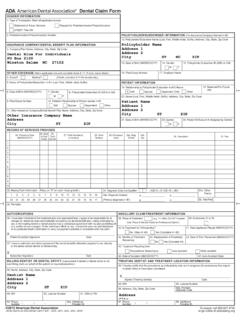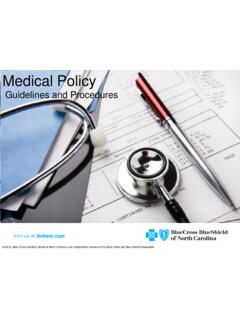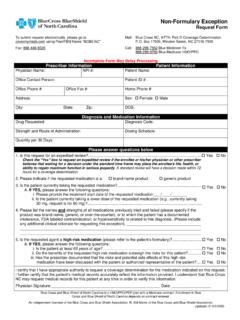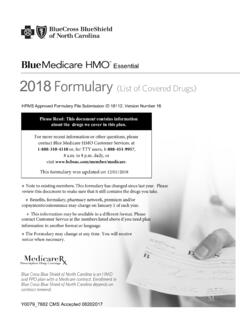Transcription of Corporate Medical Policy - Blue Cross NC
1 Corporate Medical Policy Page 1 of 18 An Independent Licensee of the Blue Cross and Blue Shield Association Breast Surgeries File Name: breast_surgeries 1/2000 8/2021 8/2022 8/2021 Origination: Last CAP Review: Next CAP Review: Last Review: Description of Procedure or Service Mastectomy is a surgical removal of all or a part of the breast. It is generally performed as treatment for breast cancer or breast disease. When a member certificate covers mastectomy, BCBSNC also covers reconstructive breast surgery resulting from the mastectomy. Procedures or services described in this Policy include the following: Section I -Reconstructive Breast Surgery after Mastectomy Section II -Surgical Treatment of Gynecomastia Section III -Reduction Mammaplasty for Breast Related Symptoms Section IV-Risk-Reducing Mastectomy Section V -Surgical Management of Breast Implants. Blue Cross and Blue Shield of North Carolina will not assign specific length of stay for patients having a mastectomy.
2 Whether the surgery is to be inpatient or outpatient and the length of stay are decisions for the attending physician. Benefits are available for the physical complications related to all stages of mastectomy for breast cancer, including treatment of associated lymphedema. Related Policies: Skin and Soft Tissue Substitutes Cosmetic and Reconstructive Surgery Gender Affirmation Surgery and Hormone Therapy Genetic Testing for Breast and Ovarian Cancer Genetic Testing for PTEN Hamartoma Tumor Syndrome **Note: This Medical Policy is complex and technical. For questions concerning the technical language and/or specific clinical indications for its use, please consult your physician. Policy BCBSNC will cover Reconstructive Breast Surgery after Mastectomy, Surgical Treatment of Gynecomastia, Reduction Mammaplasty for Breast Related Symptoms, Risk-Reducing Mastectomy, and Surgical Management of Breast Implants when it is medically necessary because the criteria shown below have been met.
3 Benefits Application This Medical Policy relates only to the services or supplies described herein. Please refer to the Member's Benefit Booklet for availability of benefits. Member's benefits may vary according to benefit Page 2 of 18 An Independent Licensee of the Blue Cross and Blue Shield Association Breast Surgeries design; therefore member benefit language should be reviewed before applying the terms of this Medical Policy . Breast surgeries included in this Policy may require prior review. SECTION I Reconstructive Breast Surgery After Mastectomy Reconstructive breast surgery is defined as a surgical procedure that is designed to restore the normal appearance of the breast after surgery, accidental injury, or trauma. There is a broadening array of surgical approaches to breast reconstruction. The most common is insertion of a breast implant, either a silicone gel-filled or saline-filled prosthesis. The implant is either inserted immediately at the time of mastectomy or sometime afterward in conjunction with the previous use of a tissue expander.
4 The breast may also be reconstructed using autologous tissues, such as a free flap, a latissimus dorsi flap, or more commonly using a transverse rectus abdominis flap (TRAM procedure). Nipple areola reconstruction or nipple tattooing may also be considered reconstructive breast surgery. Since the purpose of reconstructive breast surgery is to restore the normal appearance of the breast, reconstructive procedures such as mastopexy, reduction mammoplasty, autologous fat transplant ( , liposuction) may be performed on the nondiseased/unaffected/contralateral breast to produce a symmetrical appearance. These procedures fall into the category of reconstructive breast surgery when performed in conjunction with a contralateral mastectomy for cancer or other breast disease with associated reconstruction. Except for medically necessary reduction mammoplasty, these procedures are considered cosmetic in other circumstances. When Reconstructive Breast Surgery is covered Reconstructive breast surgery post mastectomy will be covered without regard to the time elapsed since a mastectomy.
5 It may be performed at the time of the mastectomy or anytime post-operatively as long as the mastectomy was a medically necessary procedure, , for breast cancer, or medically necessary prophylactic mastectomy, or other breast disease not responsive to conservative measures. Mastectomy refers to radical, modified radical, subcutaneous, simple, complete, or partial (lumpectomy, tylectomy, quadrantectomy, segmentectomy) procedures, with or without axillary lymphadenectomy. Reconstruction may be performed by an implant-based approach or through the use of autologous tissue. Augmentation mammaplasty, reduction mammaplasty, and/or mastopexy of a non-diseased breast will be covered following medically necessary mastectomy for the purpose of achieving reasonable breast symmetry. When Reconstructive Breast Surgery is not covered Reconstructive breast surgery is not covered when the member has a breast removed or reduced in size primarily for cosmetic reasons unrelated to mastectomy for breast cancer, medically necessary risk-reducing mastectomy or breast disease.
6 In this case, both the mastectomy and reconstruction would be excluded from coverage. Policy Guidelines Member s attending physician in consultation with the patient will determine the length of the hospital stay following a mastectomy if the member is hospitalized. Billing/Coding/Physician Documentation Information Page 3 of 18 An Independent Licensee of the Blue Cross and Blue Shield Association Breast Surgeries This Policy may apply to the following codes. Inclusion of a code in this section does not guarantee that it will be reimbursed. For further information on reimbursement guidelines, please see Administrative Policies on the Blue Cross Blue Shield of North Carolina web site at They are listed in the Category Search on the Medical Policy search page. Applicable codes: 11920, 11921, 11922, 19316, 19318, 19325, 19328, 19330, 19340, 19342, 19350, 19357, 19361, 19364, 19367, 19368, 19369, L8600, S2066, S2067, S2068. BCBSNC may request Medical records for determination of Medical necessity.
7 When Medical records are requested, letters of support and/or explanation are often useful, but are not sufficient documentation unless all specific information needed to make a Medical necessity determination is included. SECTION II Surgical Treatment of Gynecomastia Gynecomastia refers to the benign enlargement of the male breast, either due to increased adipose tissue, glandular tissue, fibrous tissue, or a combination of all three. Gynecomastia may be associated with any of the following: An underlying hormonal disorder (conditions causing either estrogen excess or testosterone deficiency, such as liver disease or an endocrine disorder) A side effect of certain drugs Obesity Related to specific age groups o neonatal gynecomastia related to action of maternal or placental estrogens o adolescent gynecomastia consisting of transient, bilateral breast enlargement o gynecomastia of aging related to the decreasing levels of testosterone and relative estrogen excess Treatment of gynecomastia involves consideration of the underlying cause.
8 For example, treatment of the underlying hormonal disorder, cessation of drug therapy or weight loss may all be effective therapies. Gynecomastia may also resolve spontaneously and adolescent gynecomastia may resolve with aging. Prolonged gynecomastia causes periductal fibrosis and stromal hyalinization which prevents regression of the breast tissue. Surgical removal of the breast tissue, using either surgical excision or liposuction may be considered if the above conservative therapies are not effective or possible and the gynecomastia does not resolve spontaneously or with aging. When Surgical Treatment of Gynecomastia is covered Surgical treatment for the condition of gynecomastia is covered when ALL of the following conditions are met: 1. Male is over 18 years of age (Male gynecomastia is not uncommon in adolescent males, and generally resolves without treatment.) or male is over 17 years of age with significant breast tissue present for over two years AND 2. Excess breast tissue is glandular and not fatty tissue.
9 (This is confirmed by clinical exam, mammogram and/or tissue pathology.) AND 3. Other causes of gynecomastia have been ruled out, including reversible drug treatments (When drugs can be discontinued). AND 4. Excessive breast development is not due to non-covered therapies or illicit drugs, , anabolic steroids or marijuana AND Page 4 of 18 An Independent Licensee of the Blue Cross and Blue Shield Association Breast Surgeries 5. If gynecomastia is caused by obesity (BMI>30), it is documented to have failed to respond to conservative measures which must include participation in a clinically supervised, comprehensive weight loss and exercise program for at least 6 months, AND 6. The patient has documented and significant Medical symptoms not resolved by more conservative treatments. When Surgical Treatment of Gynecomastia is not covered Surgical treatment of gynecomastia is not covered when the criteria listed above are not met. Policy Guidelines The evidence for surgical treatment of bilateral gynecomastia in males includes case series.
10 Relevant outcomes are functional status, health status measurements and treatment-related morbidity. There are no randomized controlled trials on surgical treatment of bilateral gynecomastia, therefore it is not possible to determine whether surgical treatment improves symptoms or functional impairment . Conservative therapy should adequately address any physical pain or discomfort and gynecomastia does not typically cause functional impairment . The evidence is insufficient to determine the effect of the technology on health outcomes. The American Society of Plastic Surgeons (ASPS) issued practice criteria for third-party payers in 2002, which was affirmed in 2015. ASPS classified gynecomastia using the following scale, which was adapted from the McKinney and Simon, Hoffman and Kohn scales : Grade I: Small breast enlargement with localized button of tissue that is concentrated around the areola. Grade II: Moderate breast enlargement exceeding areola boundaries with edges that are indistinct from the chest.
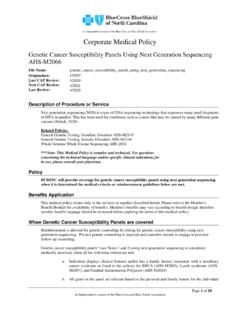
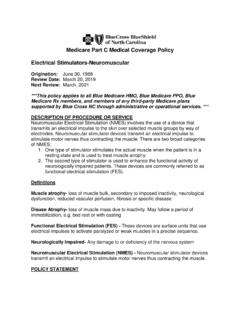
![PRESCRIBER NAME PRESCRIBER NPI [REQUIRED] …](/cache/preview/a/b/7/0/1/8/c/4/thumb-ab7018c4458f456b9838d088cff776b6.jpg)
